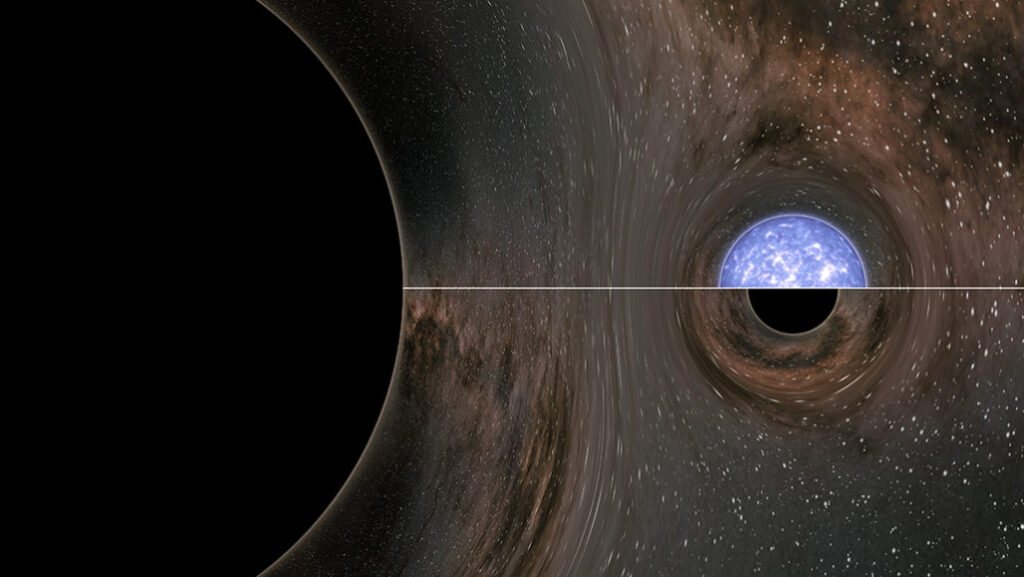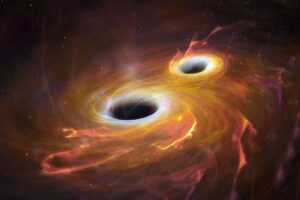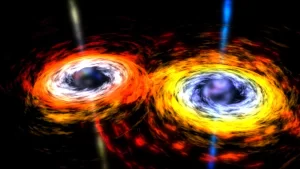Astronomers Discover New Information about Black Hole Mergers

Astronomers Discover New Information about Black Hole Mergers
While looking for gravitational waves generated with the aid of using supermassive black holes merging, astronomers the usage of the Parkes Radio Telescope have found new facts approximately the frequency and energy of black hollow mergers.
Throughout our universe, tucked inner galaxies some distance, some distance away, massive black holes are pairing up and merging. As the big our bodies dance round every different in near embraces, they ship out gravitational waves that ripple area and time themselves, whilst the waves byskip proper thru our planet Earth.
Scientists recognize those waves, expected with the aid of using Albert Einstein’s concept of relativity, exist however haven’t begun to at once hit upon one. In the race to trap the waves, one strategy — referred to as pulsar-timing arrays — has reached a milestone now no longer thru detecting any gravitational waves, however in revealing new facts approximately the frequency and energy of black hollow mergers.
“We count on that many gravitational waves are passing thru us all of the time, and now we’ve got a higher concept of the volume of this heritage activity,” stated Sarah Burke-Spolaor, co-creator of a brand new Science paper posted October 18, which describes studies she contributed to whilst primarily based totally at NASA’s Jet Propulsion Laboratory in Pasadena, California. Burke-Spolaor is now on the California Institute of Technology in Pasadena.
Gravitational waves, if detected, might display greater facts approximately black holes in addition to one of the 4 essential forces of nature: gravity.
The team’s incapacity to hit upon any gravitational waves withinside the current seek without a doubt has its personal benefits, as it well-knownshows new facts approximately supermassive black hollow mergers — their frequency, distance from Earth and masses. One concept of black hollow boom to hit the theorists’ slicing room flooring had said that mergers on my own are liable for black holes gaining mass.
The consequences come from the Commonwealth Scientific and Industrial Research Organization’s (CSIRO) Parkes radio telescope in jap Australia. The observe became together led with the aid of using Ryan Shannon of CSIRO, and Vikram Ravi, of the University of Melbourne and CSIRO.
Pulsar-timing arrays are designed to trap the diffused gravitational waves the usage of telescopes at the ground, and spinning stars referred to as pulsars. Pulsars are the burnt-out cores of exploded stars that ship out beams of radio waves like lighthouse beacons. The timing of the pulsars’ rotation is so particular that researchers say they may be similar to atomic clocks.
When gravitational waves byskip thru an array of a couple of pulsars, 20 withinside the case of the brand new observe, they set the pulsars bobbing like buoys. Researchers recording the radio waves from the pulsars can then piece collectively the heritage hum of waves.
“The gravitational waves reason the gap among Earth and pulsars to stretch and squeeze,” stated Burke-Spolaor.
The new observe used the Parkes Pulsar Timing Array, which were given its begin withinside the 1990s. According to the studies team, the array, at its modern-day sensitivity, may be capable of hit upon a gravitational wave inside 10 years.
Researchers at JPL are presently growing a comparable precision pulsar-timing functionality for NASA’s Deep Space Network, a machine of big dish antennas placed round Earth that tracks and communicates with deep-area spacecraft. During gaps withinside the network’s monitoring schedules, the antennas may be used to exactly degree the timing of pulsars’ radio waves. Because the Deep Space Network’s antennas are allotted across the globe, they are able to see pulsars throughout the complete sky, which improves sensitivity to gravitational waves.
“Right now, the point of interest withinside the pulsar-timing array groups is to increase greater touchy technology and to set up long-time period tracking packages of a big ensemble of the pulsars,” stated Walid Majid, the foremost investigator of the Deep Space Network pulsar-timing software at JPL. “All the techniques for detecting gravitational waves, which include LIGO [Laser Interferometer Gravitational-Wave Observatory], are complementary, due to the fact that every approach is touchy to detection of gravitational waves at very specific frequencies. While a few may symbolize this as a race, withinside the end, the intention is to hit upon gravitational waves, that allows you to usher withinside the starting of gravitational wave astronomy. That is the actual thrilling a part of this complete endeavor.”
The ground-primarily based totally LIGO observatory is primarily based totally in Louisiana and Washington. It is a joint challenge of Caltech and the Massachusetts Institute of Technology, Cambridge, Massachusetts, with investment from the National Science Foundation. The European Space Agency is growing the gap-primarily based totally LISA Pathfinder (Laser Interferometer Space Antenna), a proof-of-idea assignment for a destiny area observatory to hit upon gravitational waves. LIGO, LISA and pulsar-timing arrays might all hit upon specific frequencies of gravitational waves and for that reason are touchy to diverse varieties of merger events.
![Hubble Finds “Missing Link” Black Hole Tearing Apart a Star That Passed Too Close [Video]](https://aspiredworlds.com/wp-content/uploads/2022/07/Mid-Sized-Black-Hole-Eating-Star-scaled-1-300x169.jpg)






